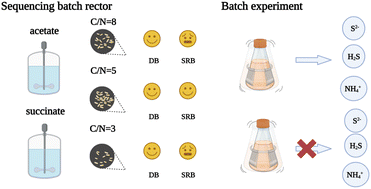Simultaneous nitrate and sulfate biotransformation driven by different substrates: comparison of carbon sources and metabolic pathways at different C/N ratios†
Abstract
Nitrate (NO3−) and sulfate (SO42−) often coexist in organic wastewater. The effects of different substrates on NO3− and SO42− biotransformation pathways at various C/N ratios were investigated in this study. This study used an activated sludge process for simultaneous desulfurization and denitrification in an integrated sequencing batch bioreactor. The results revealed that the most complete removals of NO3− and SO42− were achieved at a C/N ratio of 5 in integrated simultaneous desulfurization and denitrification (ISDD). Reactor Rb (sodium succinate) displayed a higher SO42− removal efficiency (93.79%) with lower chemical oxygen demand (COD) consumption (85.72%) than reactor Ra (sodium acetate) on account of almost 100% removal of NO3− in both Ra and Rb. Ra produced more S2− (5.96 mg L−1) and H2S (25 mg L−1) than Rb, which regulated the biotransformation of NO3− from denitrification to dissimilatory nitrate reduction to ammonium (DNRA), whereas almost no H2S accumulated in Rb which can avoid secondary pollution. Sodium acetate-supported systems were found to favor the growth of DNRA bacteria (Desulfovibrio); although denitrifying bacteria (DNB) and sulfate-reducing bacteria (SRB) were found to co-exist in both systems, Rb has a greater keystone taxa diversity. Furthermore, the potential carbon metabolic pathways of the two carbon sources have been predicted. Both succinate and acetate could be generated in reactor Rb through the citrate cycle and the acetyl-CoA pathway. The high prevalence of four-carbon metabolism in Ra suggests that the carbon metabolism of sodium acetate is significantly improved at a C/N ratio of 5. This study has clarified the biotransformation mechanisms of NO3− and SO42− in the presence of different substrates and the potential carbon metabolism pathway, which is expected to provide new ideas for the simultaneous removal of NO3− and SO42− from different media.



 Please wait while we load your content...
Please wait while we load your content...